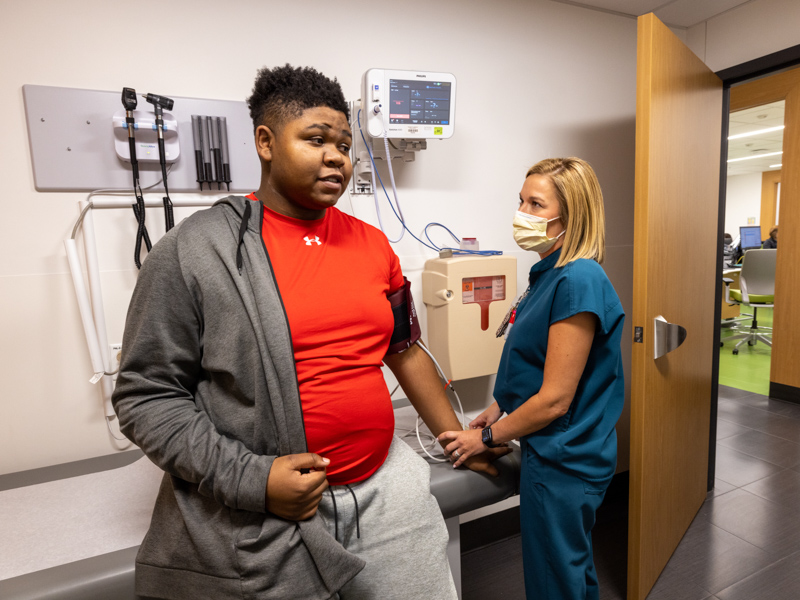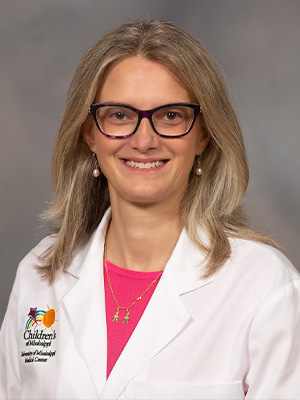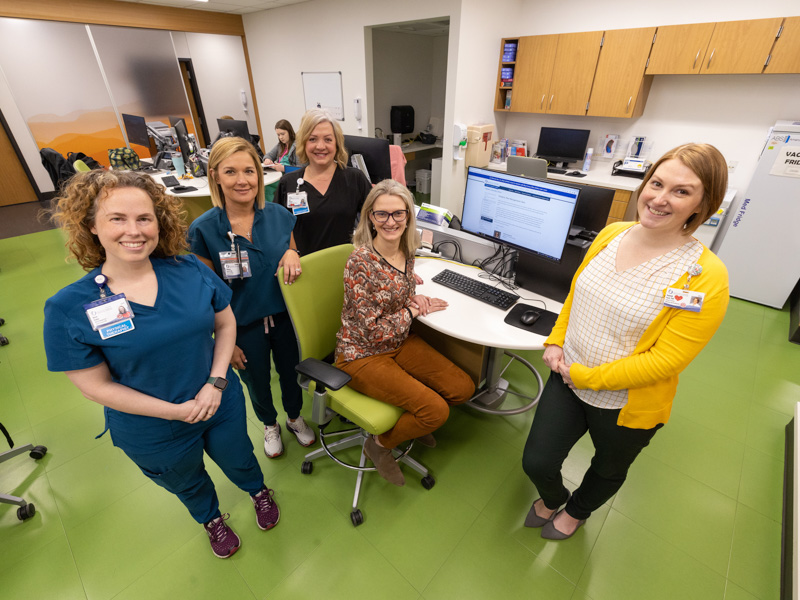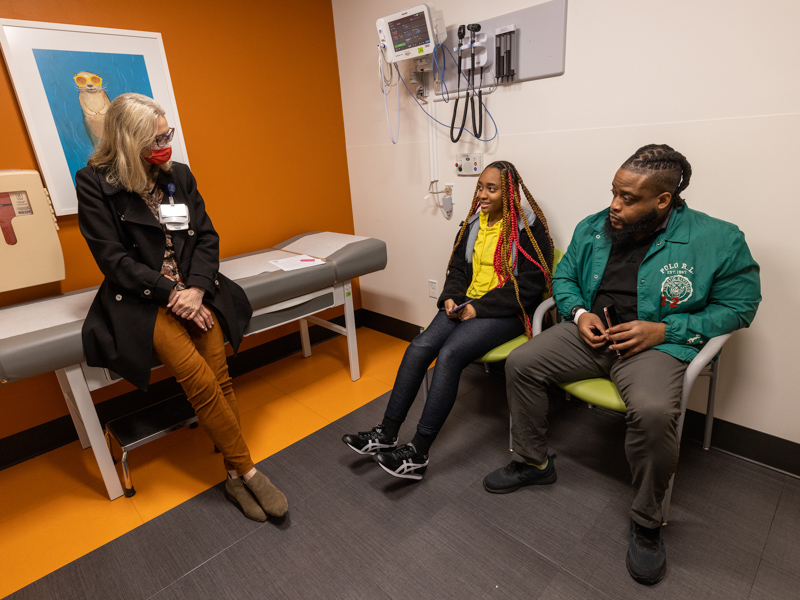Pain management clinic new addition to Sanderson Tower

Kaeden Thigpen’s right foot hurt so much that the high school student couldn’t wear a shoe. He has a chronic pain condition called complex regional pain syndrome.
For Bentonia resident Charley Shiers, 10, a fall while playing left her with back pain.
Hevyne Hinton, 14, of Hattiesburg has chronic pain resulting from amniotic band syndrome deformities that required a leg amputation below her knee.
Chronic pain may not seem like a condition of childhood and adolescence but studies say up to a third of children suffer from pain lasting three months or longer.
Treating pain in children is the focus of the transdisciplinary pediatric pain clinic opened at the Kathy and Joe Sanderson Tower at Children’s of Mississippi. The clinic is the first of its kind in Mississippi and the 56th in the country, said anesthesiologist and pediatric pain specialist Dr. Veronica Carullo, who leads the clinic team.

"The number of specialty-trained professionals in children’s pain management is still low,” she said, “but there is a growing awareness of the specialty and growth in the number of training programs.”
In addition to caring for patients at the Sanderson Tower, the team also sees patients who experience pain resulting from underlying medical conditions such as sickle cell disease or cancer at the Center for Cancer and Blood Disorders at Children’s of Mississippi and at the University of Mississippi Medical Center’s Center for Integrative Health in Ridgeland.
“Treating children’s pain makes an enormous difference in their lives,” Carullo said. “Their participation in school, family life, activity level and ability to relax can all be adversely impacted by pain.”
Children’s pain can be the result of an injury or conditions ranging from arthritis to headaches.
Some patients experience discomfort from primary pain disorders such as complex regional pain syndrome (CRPS). “Some of the pain we see is occurring in otherwise healthy children,” Carullo said.

CRPS results in pain and sensitivity in a particular spot of the body. For 16-year-old Kaeden of Hattiesburg, that spot is the top of his right foot. With hopes of going to Xavier University after high school graduation next year, Kaeden wants to ease his pain.
“I’m seeing good results so far,” he said.
His mother, Desshondra Walker, agrees. “The pain clinic has allowed him to start feeling like a normal teenager who deals with pain. He is now able to wear a shoe after not being able to for almost a year. They are teaching him ways to deal with the pain through different techniques, medicine and therapy.”
The clinic's team includes Carullo, psychologists Dr. Cindy Karlson and Dr. Hannah Ford, physical therapists Tara Husband, Annie Reiher, and Rachel Dear, and RN-care coordinator Shannon Armstrong.
The multidisciplinary approach to children’s pain treatment reflects the different factors relating to pain, Carullo said. For instance, Charley comes to Children’s of Mississippi for physical therapy and cognitive behavioral therapy to ease her persistent back pain.

“Pain treatment is not only pharmaceutical,” Carullo said. “Physical therapy can reduce pain and increase function, and cognitive behavioral therapy can treat pain and the stress, anxiety and depression that can come with it.”
Psychological intervention is essential in the treatment of chronic pain, said Ford, associate professor and director of the psychology residency program at UMMC.
"Out of all the treatments we have for chronic pain, cognitive behavioral therapy (CBT) has the most evidence,” she said. “Psychology isn’t just helpful in treating the psychiatric comorbidities, like depression or anxiety, that often occur with pain but is also helpful in treating the pain itself.”
CBT is a discussion-based therapy that helps patients identify and change negative thinking.
“The way I will often talk with patients about this is to give the analogy that pain is like an alarm system,” Ford said. “It tells us that something is wrong — our body is being harmed in some way. When we have chronic pain, our body continues to sound this alarm, even though we are not being acutely harmed. We need to help retrain our pain system to reduce these ‘false alarms’ and help patients to recognize that hurt does not necessarily equate to harm.”

CBT “involves making changes to the way we think about our pain, learning strategies to turn off this physiological alarm system, and also making behavioral changes to support a healthy lifestyle,” Ford said. “We practice lots of relaxation skills that are aimed at regulating our autonomic nervous system response, turning off that fight-or-flight response. Patients also learn cognitive strategies to change how they think about pain. We also work together to gradually build up activity to improve functioning and promote healthy behaviors. Our goal is not only to reduce pain, but more importantly, to improve functioning.”
Children’s of Mississippi physicians say the pediatric pain clinic is helping children with chronic pain enjoy fuller lives.

Patients with sickle cell disease get multidisciplinary care for chronic pain at UMMC’s Center for Integrative Health in Ridgeland, said Dr. Melissa McNaull, professor of pediatric hematology and oncology.
“Knowing that 30 percent of adults with sickle cell disease live with chronic pain, our goal is to intervene early and break that cycle,” McNaull said. “We see just four patients in an afternoon clinic because it is very time intensive. I evaluate the patients for their sickle cell disease management, Dr. Carullo does a thorough pain history and explains to the patient and family the nature of chronic pain, how it starts, what keeps it going versus what can break the cycle and sets out a treatment plan.”
Karlson performs a comprehensive pain psychology evaluation and introduces cognitive behavioral therapy, and Dear performs a comprehensive physical therapy evaluation. Patients also get a dietary plan since some foods can promote more inflammation.
Follow-up pain management care for chronic pain from sickle cell disease and cancer is offered multiple times each month at the Center for Cancer and Blood Disorders at Children’s of Mississippi with Carullo, Karlson, and nurse coordinator Shannon Armstrong.
“This is convenient for our patients and their families,” she said, “because they are coming to the place they are familiar with and can get all of their care in one place.”


